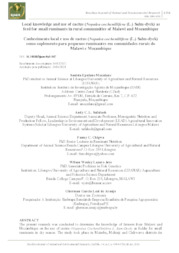Local knowledge and use of cactus (Nopalea cochenillifera(L.)Salm-dyck) as feed for small ruminants in rural communities of Malawi and Mozambique.
Local knowledge and use of cactus (Nopalea cochenillifera(L.)Salm-dyck) as feed for small ruminants in rural communities of Malawi and Mozambique.
Autoria: MACALANE, S. E.; SAFALAOH, A. C. L.; CHIGWA, F. C.; JERE, W. W. L.; ARAUJO, G. G. L. de
Resumo: The present research was conducted to determine the knowledge of farmers from Malawi and Mozambique on the use of cactus (Noppolea Cochenillinifera L. Sam-Dyck)as fodder for small ruminants in dry season.The study took place in Mzimba, Mchinjiand Chikwawa districts (in Malawi) and Manhiça, Changara and Lichinga districts (in Mozambique), where 450 farmers keeping ruminants were surveyed through semi-structured interviews. Each respondent was interviewed alone in Chewa and/or English (in Malawi) and Tsonga, Nyungwe, Yao and/or Portuguese (in Mozambique). During the interview, farmers were shown pictures stuck on a poster and numbered (no name), where they recognized the species, mentioned the local name and shared their experience on cactus as fodder. The legend of the images on the poster were listed on separate page to which farmers did not have access. Respondents were allowed to explain the preparation procedure before cacti were given to animals. They were asked to mention other uses of cactus in their region. Related uses were grouped in terms of frequency of mention. Interviews were recorded as audios on a Samsung Galax J1 cellular phone and a notepad. In addition, a literature search was undertaken in order to find some of the most common species of cactus in Africa (emphasis was given to East and Southern Africa). Images displaying stems, spines, leaves, flowers and fruits of cacti were collected. The study concluded that most farmers and probably other residents from the districts and villages where the present study was conducted knew cactus as medicine, edible fruit, ornament and live fence. The knowledge of cacti as fodder both in Malawi and Mozambique was negligible.
Ano de publicação: 2021
Tipo de publicação: Artigo de periódico
Unidade: Embrapa Semiárido
Observações
1 - Por padrão são exibidas publicações dos últimos 20 anos. Para encontrar publicações mais antigas, configure o filtro ano de publicação, colocando o ano a partir do qual você deseja encontrar publicações. O filtro está na coluna da esquerda na busca acima.
2 - Para ler algumas publicações da Embrapa (apenas as que estão em formato ePub), é necessário ter, no celular ou computador, um desses softwares gratuitos. Sistemas Android: Google Play Livros; IOS: iBooks; Windows e Linux: software Calibre.
Acesse outras publicações
Acesse a Base de Dados da Pesquisa Agropecuária (BDPA) para consultar o acervo completo das bibliotecas da Embrapa.

